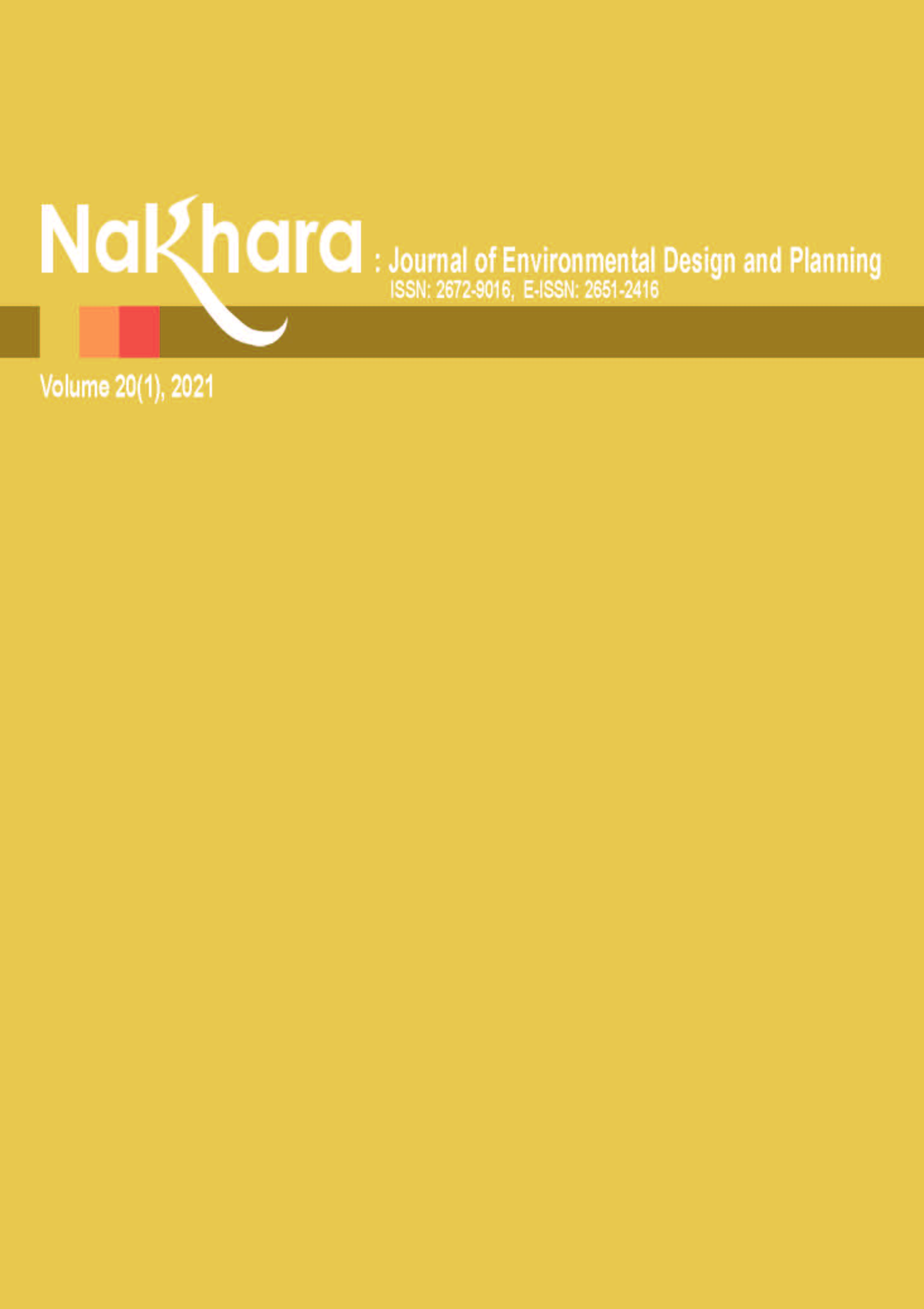Ethnographic Approach for Research on Vernacular Architecture: Four Case Studies of Indigenous Communities in Indonesia
Main Article Content
Abstract
Many ethnic groups with unique cultures exist in Indonesia, but their vernacular architecture and living cultures need to be supported to ensure sustainability. One example of how a more anthropological approach to the design and planning of the built environment requires a better understanding is the study of the living culture of indigenous communities. Unsurprisingly, an ethnographic approach is critical to studying these communities' architecture and living culture in Indonesia. This study aims to outline the main principles of the ethnographic approach and review the implementation of these principles in previous studies on the vernacular architecture of indigenous communities in Indonesia. A comparative analysis of four case studies shows that each study has implemented the approach's main principles contextually. The results showed that the four case studies utilized observation and interviews to collect field data in slightly different terms. Although each case study's objectives, focus, and issues were different, the researchers managed to provide a cultural portrait that included the participants' views (emic) and the researcher's opinions (etic). The similarities between the four communities are religious or belief systems affecting the architecture and living culture, which are cultural aspects that significantly affect each case as part of the findings embodied in themes resulting from interpretation. These results can help to develop guidelines for designers and planners working in indigenous communities. Through ethnographic studies, architects and planners can understand indigenous communities' point of view (etic) to integrate their perspectives (emic) when working hand in hand with the community.
Article Details

This work is licensed under a Creative Commons Attribution-NonCommercial-NoDerivatives 4.0 International License.
References
Arifin, E. N., Ananta, A., Wilujeng Wahyu Utami, D. R., Budi Handayani, N., & Pramono, A. (2015). Quantifying Indonesia’s ethnic diversity. Asian Population Studies, 11(3), 233–256. https://doi.org/10.1080/17441730.2015.1090692
Auersbach, B. (2018). The house, the rice and the buffalo: Cosmological perceptions in the indigenous architecture of Southeast Asia. SPAFA Journal, 2, 1–8. https://doi.org/10.26721/spafajournal.v2i0.586
Badan Meteorologi Klimatologi dan Geofisika. (2020). Himawari-8 natural color - Indonesia. Retrieved November 22, 2020, from https://www.bmkg.go.id/satelit/satelit.bmkg?Sat=1&id=0
Bappenas. (2013). Masyarakat adat di Indonesia: Menuju perlindungan sosial yang inklusif [Indigenous peoples in Indonesia: Towards inclusive social protection]. Jakarta, Indonesia: Direktorat Perlindungan dan Kesejahteraan Masyarakat, Kementrian PPN/Bappenas.
Creswell, J. W. (2013). Qualitative inquiry & research design: Choosing among five approaches (3rd ed.). SAGE.
Febrianto, R. S., Wulandari, L. D., & Santosa, H. (2016). Ekspresi lanskap-agrikultur dan pola permukiman masyarakat peladang di Madura Timur [Agricultural landscape expressions and rural settlement patterns of communities in East Madura]. Review of Urbanism and Architectural Studies, 14(2), 11–23. https://doi.org/10.21776/ub.ruas.2016.014.02.2
Febrianto, R. S., Wulandari, L. D., & Santosa, H. (2018). Pola spasial teritori pada lanskap-hunian masyarakat peladang desa Juruan Laok Madura Timur [Spatial patterns of the territory in the residential landscape of the farmers in Juruan Laok Village, East Madura]. ARTEKS, Jurnal Teknik Arsitektur, 2(1), 59. https://doi.org/10.30822/artk.v2i1.140
Koentjaraningrat, R. M. (2005). Pengantar antropologi: Pokok-pokok etnografi II [Introduction to anthropology: Ethnographic essentials II]. Rineka Cipta.
Lake, R. C. (2016). Tata spasial arsitektur tradisional suku Atoni Di Kampung Tamkesi Pulau Timor [Spatial planning of traditional architecture as abserved among the Atoni Tribe in the Tamkesi Kampong on Timor Island]. ATRIUM Jurnal Arsitektur, 2(1), 31–41. https://doi.org/10.21460/atrium.v2i1.51
Lucas, R. (2016). Research methods for architecture. Laurence King Publishing.
Martana, S. P. (2006). Problematika penerapan metode field research untuk penelitian arsitektur vernakular di Indonesia [The application problems of field research methods on vernacular architecture in Indonesia]. DIMENSI (Jurnal Teknik Arsitektur), 34(1), 59–66. https://ojs.petra.ac.id/ojsnew/index.php/ars/article/download/16458/16450
Muchamad, B. N., Dharoko, T. A., Ronald, A., & Ahimsa-Putra, H. S. (2013). Transformasi permukiman suku Dayak Bukit (dari Pondok menjadi Kampung) [The Transformation of the settlement of the Dayak Bukit Tribe (from Pondok to Kampung)]. Jurnal Arsitektur Dan Perencanaan, 6(1), 18–25.
Rapoport, A. (1969). House form and culture. Prentice-Hall.
Schefold, R. (2003). The Southeast Asian-type house: Common features and local transformations of an ancient architectural tradition. In R. Schefold, G. Domenig, & P. Nas (Eds.), Indonesian houses: Tradition and transformation in vernacular architecture (pp. 19–60). KITLV Press.
Spradley, J. P. (2016). The Ethnographic Interview. Waveland Press, Inc.
Sri Rejeki, V. G. (2012). Tata bermukim berbasis punden desa Kapencar, lereng gunung Sindoro, kabupaten Wonosobo [The Punden-based settlement system in Kapencar Village on the slope of Mount Sindoro, Wonosobo Regency]. Universitas Gadjah Mada Yogyakarta.
Sri Rejeki, V. G., Soewarno, N., Sudaryono, S., & Subroto, T. Y. W. (2010). Nilai kosmologi pada tata spasial permukiman desa Kapencar, lereng gunung Sindoro, Wonosobo [Cosmological Value in the Spatial Layout of Settlement in Kapencar Village on the slope of Mount Sindoro, Wonosobo]. Forum Teknik, 33(3), 140–148. https://jurnal.ugm.ac.id/mft/article/view/654/504
Tallo, A. J. (2013). Strukur ruang permukiman suku Atoni berbasis budaya, studi kasus: Kampung adat Tamkesi kabupaten Timor tengah utara [Cultural-based settlement structure for the Atoni Tribe: A case study of Tamkesi Traditional Village, North Central Timor Regency]. Tesa Arsitektur Journal of Architectural Discourses, 11(1), 16–30. Retrieved from https://journal.unika.ac.id/index.php/tesa/article/download/221/215
Vellinga, M. (2005). Anthropology and the challenges of sustainable architecture. Anthropology Today, 21(3), 3–7. https://doi.org/10.1111/j.0268-540X.2005.00351.x

